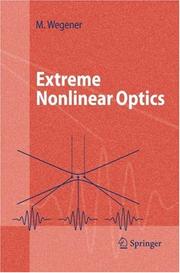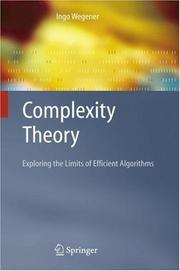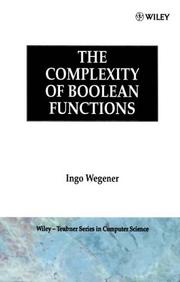| Listing 1 - 10 of 187 | << page >> |
Sort by
|

ISSN: 14392674 ISBN: 354022291X 3642060900 3540266887 9783540222910 Year: 2005 Publisher: Berlin, Heidelberg : Springer Berlin Heidelberg : Imprint: Springer,
Abstract | Keywords | Export | Availability | Bookmark
 Loading...
Loading...Choose an application
- Reference Manager
- EndNote
- RefWorks (Direct export to RefWorks)
Following the birth of the laser in 1960, the field of "nonlinear optics" rapidly emerged. Today, laser intensities and pulse durations are readily available, for which the concepts and approximations of traditional nonlinear optics no longer apply. In this regime of "extreme nonlinear optics," a large variety of novel and unusual effects arise, for example frequency doubling in inversion symmetric materials or high-harmonic generation in gases, which can lead to attosecond electromagnetic pulses or pulse trains. Other examples of "extreme nonlinear optics" cover diverse areas such as solid-state physics, atomic physics, relativistic free electrons in a vacuum and even the vacuum itself. This book starts with an introduction to the field based primarily on extensions of two famous textbook examples, namely the Lorentz oscillator model and the Drude model. Here the level of sophistication should be accessible to any undergraduate physics student. Many graphical illustrations and examples are given. The following chapters gradually guide the student towards the current "state of the art" and provide a comprehensive overview of the field. Every chapter is accompanied by exercises to deepen the reader's understanding of important topics, with detailed solutions at the end of the book.
Nonlinear optics --- Optique non linéaire --- Nonlinear optics. --- Light & Optics --- Physics --- Physical Sciences & Mathematics --- Optics. --- Optique non linéaire --- EPUB-LIV-FT LIVPHYSI SPRINGER-B --- Optics, Nonlinear --- Physics. --- Gravitation. --- Electrodynamics. --- Quantum optics. --- Statistical physics. --- Dynamical systems. --- Engineering. --- Optics and Electrodynamics. --- Engineering, general. --- Quantum Optics. --- Statistical Physics, Dynamical Systems and Complexity. --- Classical and Quantum Gravitation, Relativity Theory. --- Light --- Optics --- Lasers --- Classical Electrodynamics. --- Complex Systems. --- Statistical Physics and Dynamical Systems. --- Mathematical statistics --- Construction --- Industrial arts --- Technology --- Statistical methods --- Photons --- Quantum theory --- Field theory (Physics) --- Matter --- Antigravity --- Centrifugal force --- Relativity (Physics) --- Dynamical systems --- Kinetics --- Mathematics --- Mechanics, Analytic --- Force and energy --- Mechanics --- Statics --- Dynamics --- Properties --- Acqui 2006 --- Dynamics.

ISBN: 3540210458 3642059147 3540274774 Year: 2005 Publisher: Berlin, Heidelberg : Springer Berlin Heidelberg : Imprint: Springer,
Abstract | Keywords | Export | Availability | Bookmark
 Loading...
Loading...Choose an application
- Reference Manager
- EndNote
- RefWorks (Direct export to RefWorks)
Complexity theory is the theory of determining the necessary resources for the solution of algorithmic problems and, therefore, the limits of what is possible with the available resources. An understanding of these limits prevents the search for non-existing efficient algorithms. This textbook considers randomization as a key concept and emphasizes the interplay between theory and practice: New branches of complexity theory continue to arise in response to new algorithmic concepts, and its results - such as the theory of NP-completeness - have influenced the development of all areas of computer science. The topics selected have implications for concrete applications, and the significance of complexity theory for today's computer science is stressed throughout.
Algorithms. --- Algorithmes --- Algorithms --- Computer Science --- Mathematical Theory --- Mathematics --- Engineering & Applied Sciences --- Physical Sciences & Mathematics --- Constructive mathematics. --- EPUB-LIV-FT LIVINFOR SPRINGER-B --- Mathematics, Constructive --- Algorism --- Computer science. --- Computer programming. --- Coding theory. --- Computer logic. --- Mathematical logic. --- Computer Science. --- Programming Techniques. --- Algorithm Analysis and Problem Complexity. --- Coding and Information Theory. --- Logics and Meanings of Programs. --- Mathematical Logic and Formal Languages. --- Algebra --- Arithmetic --- Foundations --- Logic, Symbolic and mathematical --- Computer software. --- Logic design. --- Data compression (Telecommunication) --- Digital electronics --- Information theory --- Machine theory --- Signal theory (Telecommunication) --- Computer programming --- Design, Logic --- Design of logic systems --- Electronic circuit design --- Logic circuits --- Switching theory --- Software, Computer --- Computer systems --- Informatics --- Science --- Information theory. --- Algebra of logic --- Logic, Universal --- Mathematical logic --- Symbolic and mathematical logic --- Symbolic logic --- Algebra, Abstract --- Metamathematics --- Set theory --- Syllogism --- Computer science logic --- Communication theory --- Communication --- Cybernetics --- Computers --- Electronic computer programming --- Electronic data processing --- Electronic digital computers --- Programming (Electronic computers) --- Coding theory --- Programming --- Logic, Symbolic and mathematical.
Book
ISBN: 038718872X 9780387188720 Year: 1989 Publisher: New York (N.Y.) : Springer,
Abstract | Keywords | Export | Availability | Bookmark
 Loading...
Loading...Choose an application
- Reference Manager
- EndNote
- RefWorks (Direct export to RefWorks)

ISBN: 0471915556 9780471915553 Year: 1987 Publisher: Chicester [West Sussex: Wiley,
Abstract | Keywords | Export | Availability | Bookmark
 Loading...
Loading...Choose an application
- Reference Manager
- EndNote
- RefWorks (Direct export to RefWorks)
Algebra, Boolean --- Computational Complexity --- Algebra, Boolean. --- Computational complexity.
Book
ISBN: 3319248219 3319248235 Year: 2016 Publisher: Cham : Springer International Publishing : Imprint: Springer,
Abstract | Keywords | Export | Availability | Bookmark
 Loading...
Loading...Choose an application
- Reference Manager
- EndNote
- RefWorks (Direct export to RefWorks)
This book reviews several aspects of the biological response to nanoscale particles on a molecular and cellular level. Nanoscale materials and nanoscale particles in particular have interesting properties and beneficial applications. While they thus have entered our daily lifes on many different levels (from electronics, over textiles, packaging or surface modifications, to biomedical applications), general rules describing their interaction with biological structures and biological matter are still difficult to derive. The existing literature suggests a variety of interaction schemes between nanoparticles and biological objects, not dispelling the public concerns about possible health effects and harmful properties. A systematic approach to the problem is needed and timely. This book specifically emphasizes bioanalytical problems starting from the characterization of the nanomaterials to the pitfalls and potential artifacts of state-of-the-art cytotoxicity assays that are frequently used to study harmful effects on cells. It also highlights the application of label-free bioanalytical techniques that can potentially complement the present approaches and hence provide new perspectives on this highly discussed cutting-edge field of research and public concern.
Analytical Chemistry --- Chemistry --- Physical Sciences & Mathematics --- Nanostructured materials. --- Nanomaterials --- Nanometer materials --- Nanophase materials --- Nanostructure controlled materials --- Nanostructure materials --- Ultra-fine microstructure materials --- Microstructure --- Nanotechnology --- Analytical biochemistry. --- Nanochemistry. --- Biochemistry. --- Medicine. --- Biotechnology. --- Analytical Chemistry. --- Biochemistry, general. --- Biomedicine general. --- Biological and Medical Physics, Biophysics. --- Chemical engineering --- Genetic engineering --- Clinical sciences --- Medical profession --- Human biology --- Life sciences --- Medical sciences --- Pathology --- Physicians --- Biological chemistry --- Chemical composition of organisms --- Organisms --- Physiological chemistry --- Biology --- Nanoscale chemistry --- Chemistry, Analytic --- Nanoscience --- Analytic biochemistry --- Biochemistry --- Composition --- Analytical chemistry. --- Biophysics. --- Biological physics. --- Biomedicine, general. --- Biological physics --- Physics --- Analysis, Chemical --- Analytical chemistry --- Chemical analysis --- Metallurgical analysis --- Mineralogy, Determinative --- Health Workforce --- Analytic chemistry
Book
ISSN: 09337636 ISBN: 9783110289473 9783110289657 3110289652 3110289474 9781283857185 1283857189 3110289652 Year: 2012 Volume: 61 Publisher: Berlin ; Boston : De Gruyter Mouton,
Abstract | Keywords | Export | Availability | Bookmark
 Loading...
Loading...Choose an application
- Reference Manager
- EndNote
- RefWorks (Direct export to RefWorks)
This is the first comprehensive description of Savosavo, a non-Austronesian (Papuan) language spoken by approximately 2,500 speakers on Savo Island, Solomon Islands. Based on primary field data recorded by the author, it provides an overview of all levels of grammar. In addition, a full chapter is dedicated to nominalization of verbs by means of one particular suffix, which occur in a number of constructions ranging from lexical to syntactic nominalization. The appendix provides glossed example texts and a list of lexemes.
Austronesian languages --- Grammar --- Solomon Islands --- Papuan languages --- Oceanic languages --- Grammar, Comparative --- Languages. --- Eastern Austronesian languages --- Proto-Oceanic language --- Melanesian languages. --- Grammar. --- Melanesia. --- Papuan Languages. --- Solomon Islands.
Book
ISBN: 3030324338 303032432X Year: 2019 Publisher: Cham : Springer International Publishing : Imprint: Springer,
Abstract | Keywords | Export | Availability | Bookmark
 Loading...
Loading...Choose an application
- Reference Manager
- EndNote
- RefWorks (Direct export to RefWorks)
This book is dedicated to label-free, non-invasive monitoring of cell-based assays and it comprises the most widely applied techniques. Each approach is described and critically evaluated by an expert in the field such that researchers get an overview on what is possible and where the limitations are. The book provides the theoretical basis for each technique as well as the most successful and exciting applications. Label-free bioanalytical techniques have been known for a long time as valuable tools to monitor adsorption processes at the solid-liquid interface in general – and biomolecular interaction analysis (BIA) in particular. The underlying concepts have been progressively transferred to the analysis of cell-based assays. The strength of these approaches is implicitly given with the name 'label-free': the readout is independent of any label, reagent or additive that contaminates the system under study and potentially affects its properties. Thus, label-free techniques provide an unbiased analytical perspective in the sense that the sample is not manipulated by additives but pure. They are commonly based on physical principles and read changes in integral physical properties of the sample like refractive index, conductivity, capacitance or elastic modulus to mention just a few. Even though it is not implied in the name, label-free approaches usually monitor the cells under study non-invasively meaning that the amplitude of the signal (e.g. electric field strength, mechanical elongation) that is used for the measurement is too low to interfere or affect. In contrast to label-based analytical techniques that are commonly restricted to a single reading at a predefined time point, label-free approaches allow for a continuous observation so that the dynamics of the biological system or reaction become accessible.
Analytical chemistry. --- Nanochemistry. --- Laboratory medicine. --- Cell culture. --- Biophysics. --- Biological physics. --- Analytical Chemistry. --- Laboratory Medicine. --- Cell Culture. --- Biological and Medical Physics, Biophysics. --- Biological assay. --- Assay, Biological --- Bioassay --- Biology --- Methodology --- Biological physics --- Medical sciences --- Physics --- Cultures (Biology) --- Cytology --- Clinical medicine --- Clinical pathology --- Diagnostic laboratory tests --- Laboratory diagnosis --- Laboratory medicine --- Medical laboratory diagnosis --- Diagnosis --- Pathology --- Nanoscale chemistry --- Analytical chemistry --- Nanoscience --- Analysis, Chemical --- Analytic chemistry --- Chemical analysis --- Chemistry, Analytic --- Chemistry --- Technique

ISBN: 0226878937 Year: 1992 Publisher: Chicago (Ill.) : University of Chicago press,
Abstract | Keywords | Export | Availability | Bookmark
 Loading...
Loading...Choose an application
- Reference Manager
- EndNote
- RefWorks (Direct export to RefWorks)
Book
ISBN: 0226878910 Year: 1978 Publisher: Chicago (Ill.) : University of Chicago press,
Abstract | Keywords | Export | Availability | Bookmark
 Loading...
Loading...Choose an application
- Reference Manager
- EndNote
- RefWorks (Direct export to RefWorks)
Education, Humanistic. --- Universities and colleges --- Curricula.
Book
Year: 2004 Publisher: Fink
Abstract | Keywords | Export | Availability | Bookmark
 Loading...
Loading...Choose an application
- Reference Manager
- EndNote
- RefWorks (Direct export to RefWorks)
| Listing 1 - 10 of 187 | << page >> |
Sort by
|

 Search
Search Feedback
Feedback About UniCat
About UniCat  Help
Help News
News